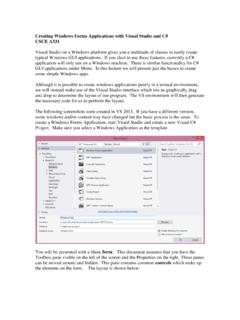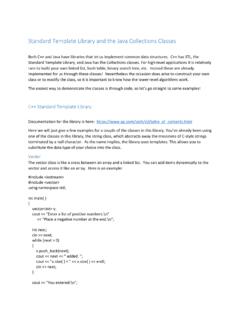Transcription of Random Number Generation C++ - math.uaa.alaska.edu
1 Random Number Generation C++ It is often useful to generate Random numbers to produce simulations or games (or homework problems :) One way to generate these numbers in C++ is to use the function rand(). Rand is defined as: #include <cstdlib> int rand(); The rand function takes no arguments and returns an integer that is a pseudo- Random Number between 0 and RAND_MAX. On transformer, RAND_MAX is 2147483647. What is a pseudo- Random Number ? It is a Number that is not truly Random , but appears Random . That is, every Number between 0 and RAND_MAX has an equal chance (or probability) of being chosen each time rand() is called. (In reality, this is not the case, but it is close). For example, the following program might print out: cout <<rand() << endl; cout <<rand() << endl; cout <<rand() << endl; 1804289383 846930886 1681692777 Here we randomly were given numbers between 0 and RAND_MAX.
2 What if we only wanted numbers between 1 and 10? We will need to scale the results. To do this we can use the modulus (%) operator. Any integer modulus 10 will produce a Number from 0-9. In other words, if we divide a Number by 10, the remainder has to be from 0 to 9. It s impossible to divide a Number by 10 and end up with a remainder bigger than or equal to ten. In our case: 1804289383% 10 = 3 846930886% 10 = 6 1681692777% 10 = 7 Consequently, we can take rand() % 10 to give us numbers from 0-9. If we want numbers from 1-10 we can now just scale up by adding one. The final result is: cout << (rand() % 10) + 1 << endl; If you run this program many times, you ll quickly notice that you end up with the same sequence of Random numbers each time.
3 This is because these numbers are not truly Random , but pseudorandom. Repeat calls to rand merely return numbers from some sequence of numbers that appears to be Random . Each time we call rand, we get the next Number in the sequence. If we want to get a different sequence of numbers for each execution, we need to go through a process of randomizing. Randomizing is seeding the Random Number sequence, so we start in a different place. The function that does this is srand() which takes an integer as the seed: void srand(int seed); It is important to only invoke the srand call ONCE at the beginning of the program. There is no need for repeat calls to seed the Random Number generator (in fact, it will make your Number less evenly distributed). A commonly used technique is to seed the Random Number generator using the clock.
4 The time() function will return the computer s time. On transformer, this is expressed in terms of the Number of seconds that have elapsed since Jan 1, 1970 (the Epoch). The function time(NULL) will return the Number of seconds elapsed in computer time. #include <ctime> srand(time(NULL)); cout << (rand() %10) + 1; This produces different values each time the program is run. Call By Value C++ and Java Both Java and C++ invoke functions using a mechanism called Call By Value . If we pass a variable to a function then the function gets the value contained in the variable. However, any changes that are made to the variable in the function are not reflected back in the calling program. These parameters are considered local variables. To illustrate, consider the following: void ChangeValues(int x); // Prototype int main() { int x=5; ChangeValues(x); cout << Back in main: << x << endl; return 0; } void ChangeValues(int x) { cout << In change values: << x << endl; x = 10; cout << In change values: << x << endl; return; } When this program is run, we get: In change values: 5 In change values: 10 Back in main: 5 Note that inside the function ChangeValues, we initially get x=5, or the value that was assigned in main to x.
5 Then x is changed to 10, and the new change is reflected in the print statement. However, when we return back to the main function, x is unchanged and is back to 5. The parameter x inside ChangeValues is referred to as a local variable, because changes to it are only enforced within the scope of the function. We ll have more to say about scoping later. Note that we can still have functions that use pass by value, but return a value: int ChangeValues(int x); // Prototype int main() { int x=5, y=0; y=ChangeValues(x); cout << Back in main x= << x << y= << y << endl; return 0; } int ChangeValues(int x) { int y; y = 20; x = 10; return 10; } This will output: Back in main, x=5 y=10 Or we returned a value of 10 which is reflected in main.
6 The variable y defined in ChangeValues is also a local variable, and only exists within the scope of the ChangeValues function. Back in main, we are referencing main s variable y, not the y defined in ChangeValues. Underneath the Hood The Stack and Parameter Passing What is happening when we call functions and pass parameters back and forth? It is very useful to know how this is done architecturally in the computer. Local variables and parameters are passed using the stack in the computer. The Stack You can visualize the stack like a stack of trays in a cafeteria. A person grabs a tray from the top of the stack. Clean trays are also added to the top of the stack. In general operation, you never touch anything that is not on top of the stack.
7 This has the property of LIFO Last In, First Out. The last thing you put into the stack is the first thing that will be taken out. In contrast, the first thing put into the stack is the last thing that is taken out. The computer implements the stack using a chunk of memory, with a special register named the stack pointer that remembers the place in memory that contains the top of the stack. Let s say our stack pointer is currently pointing to memory address 255. We push stack frames onto the stack, where each stack frame contains data of variable size that we would like to store. Here is an initial picture: Let s say that we push a stack frame containing the numbers 100 and 200 that occupies two memory locations. The memory picture now looks like this: If we push another stack frame with the numbers 999, 999, and 999 that occupies three memory locations then now the memory picture looks like this: If we pop the top stack frame then we are back to this: Note that the computer must know where the bounds of the stack are, or we might overrun into memory that is not allocated for the stack.
8 What is the stack used for? When we call a function, it is used to store the contents of variables and to remember what the next instruction is that we should execute when the function returns. This is needed in case there is an arbitrary Number of nested functions (or recursion!) Let s see how our stack might look upon this simple ChangeValues sample program. I have added line numbers to indicate lines of code, which would map to memory addresses in the computer. 1 int main() 2 { 3 int x=5, y=0; 4 y=ChangeValues(x); 5 cout << "Back in main x= " << x << " y=" << y << endl; 6 return 0; 7 } 8 int ChangeValues(int x) 9 { 10 int y; 11 y = 20; 12 x = 10; 13 return 10; 14 } Variables are actually defined on the stack, so when main executes, it is going to declare variables x and y in terms of a stack frame.
9 These are called automatic or auto variables. Upon starting main: When main is executing, the knows which memory addresses are used to store variables x and y. What happens when we make the function call to ChangeValues() ? We make a new stack frame for ChangeValues that contains data for the parameters and local variables. We also need to remember the place in memory we should resume execution after the function returns. This is called the return address, which in this example maps back to line 5 in the code (actually line 4 since we need to do the assignment to y). This stack frame is pushed onto the stack and we decrement the stack pointer to hold the new stack frame. There is other bookkeeping data to keep track of on the stack, but we will skip those details for this class.
10 You will cover it in more detail in computer organization & architecture. Now, when ChangeValues changes the variables x and y they are changed only in its stack frame. The values in main are unchanged even though they have the same names in the source code. When the return function is executed, we pop off the stack frame and resume execution at the return address. This has the effect of throwing away the local variables. We are back to the original state of the stack before making the function call: Note that the old values are still sitting on the stack, but the next time a new stack frame is pushed onto the stack we may overwrite the old values. The process of using the stack varies from machine to machine and compiler to compiler, but the basic process is the same.










